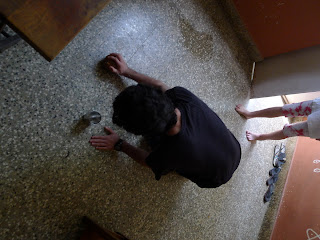 |
| My slightly worn copy of "Sichuan Cookery" |
"Sichuan Cookery” became an instant classic of its genre; since publication it regularly appears on food writer’s lists of the best cookbooks of all time and Fuchsia Dunlop is now a ‘foodie superstar’ – writing more books and articles on the subject and invited to food festivals around the world.
 |
| English-born Chinese food exponent, Fuchsia Dunlop |
Now restaurant reviewers and customers in Melbourne compare notes on the best xiao long bao dumplings and pan-fried pork potstickers, cue up in the winter rain outside the Dainty Sichuan restaurant and slaver over grilled oysters and chilli crabs. There’s even cuisine-focused tours of China in the offing.
 |
| Fuchsia Dunlop in China |
As she wrote in the introduction to the book, “Chinese people say that ‘China’ is the place for food but Sichuan is the place for flavour’, and local gourmets claim that the region boasts some 5,000 different dishes ... In Europe, strangely, Chinese cuisine is almost always treated as one great tradition, with some regional variations ... (but) viewed from the inside, it is the differences that seem to matter, the differences between the fresh natural flavours of the south, the sweeter, oilier cooking of the eastern coastal areas and the spicy western diet; between the wheaten staples of the north and the southern rice-based diet.”
Fuchsia Dunlop speaks and reads Mandarin and has written a number of bestselling books on Chinese regional cuisine since this first publication; she also regularly contributes to the UK newspapers The Guardian, The Observer and The Financial Times. Her second book - “The Revolutionary Chinese Cookbook” came out in 2006 and focuses on the southern central province of Hunan, home to many Chinese communist revolutionaries including Chairman Mao Zedong. Then, after publishing an autobiography - ”Shark’s Fin and Sichuan Pepper”, she released “Every Grain of Rice” earlier this year, a book which focuses on simple Chinese home style cooking from across the country.
 |
| Sichuanese style steamed fish (before cooking) from "Sichuan Cookery" |
I have been cooking from “Sichuan Cookery” since it was first published in 2001 and at the time found it relatively easy to hunt down exotic and rare ingredients in Melbourne’s Chinese supermarkets ... especially in Richmond or Chinatown in the city. But here in Hyderabad it’s been more of a challenge.
However, gradually ingredients such as Sichuan peppercorns, dried Chinese mushrooms, higher quality soy sauce and sesame oil have become available in some local supermarkets. And after a recent trip to Delhi, where the markets are far more cosmopolitan and ‘international’ than their counterparts in the south of India, I have also begun ordering more hard to find ingredients such as Korean chilli paste, Japanese miso and udon noodles from shops in the country’s capital and had them delivered to Hyderabad. (Couriering goods around the country here is much cheaper than in Australia!)
 |
| Ma Po Dou Fu after adding the leeks & cornflour |
It can be served as a stand alone meal in a bowl or with rice and a salad. I usually accompany Ma Po with the “Smashed Cucumber Salad” from the “Revolutionary Chinese Cookbook”.
Try it – its fantastic!
MA PO DOU FU POCK-MARKED MOTHER CHEN’S BEANCURD
Ingredients:
1 block of beancurd, 400 - 500gm 4 baby leeks or spring onions 100ml cooking oil 150 – 250 gm minced pork, beef or lamb 2 ½ T Sichuanese chilli paste (I use other chilli paste if I cant find this in India!) 1 T black fermented beans (You could use black bean sauce – again for the same reason) 2 t ground Sichuanese chillis (or dried red chillis) 250 – 300 ml stock 1 t caster sugar 2 t light soy sauce 3 T cornflour mixed with 4 T cold water ½ - 1 t toasted & ground Sichuan peppercorns (no substitute!)
Cut beancurd block into 2cm cubes and steep in slightly salted hot water. Slice leeks or spring onions on angle into ‘horse ear’ shape.
 |
| Cubes of beancurd soaking in hot water |
Pour in stock, stir, and then gently add beancurd. Stir into mixture - careful not to break up the cubes. Add sugar, some salt and 2 t of soy sauce. Simmer for 5 mins until beancurd has absorbed chilli flavour.
Add leeks or spring onions and stir in gently. Add cornflour mixture in 3 parts and stir until mixture has thickened ... but not too much.
Pour into bowl and sprinkle with Sichuan peppercorns.
PAI HUANG GUA SMACKED CUCUMBERS
Ingredients:
1 to 3 cucumbers, depending on size (about 400gms) salt 2 T very finely chopped garlic 2 T rice vinegar 2 T vegetable oil 1 T dried chilli flakes
 |
| The cucumbers after being smacked with a cleaver! |
Method:
Place cucumber(s) on chopping board and whack several times with the edge of a cleaver or the back end of a knife, to form jagged cuts in the cucumber. The cut into slices ... I cut Japanese style - on the angle, rotating cucumber a ¼ turn before each cut.
Place in salad bowl and add ½ t salt, toss with hands to combine and then leave for 30 mins. Drain off the water that has accumulated in bottom of the bowl.
Add garlic and vinegar to bowl, toss again and allow several minutes for flavours to blend.
Sprinkle chilli flakes over the cucumbers. Heat the oil in a small pan to smoking point and then pour quickly over bowl with cucumbers.
Mix well and serve with the Ma Po.
Tony saab, Hyderabad Dec 2012




































.jpg)







